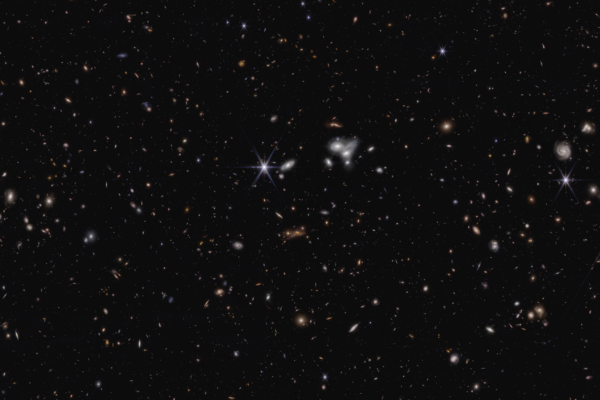AUSTIN, Texas – Researchers have discovered the most distant active supermassive black hole to date with the James Webb Space Telescope (JWST). The galaxy, CEERS 1019, existed about 570 million years after the big bang, and its black hole is less massive than any other yet identified in the early universe.
In addition to the black hole in CEERS 1019, the researchers identified two more black holes that are on the smaller side and existed 1 billion and 1.1 billion years after the big bang. JWST also identified eleven galaxies that existed when the universe was 470 million to 675 million years old. The evidence was provided by JWST’s Cosmic Evolution Early Release Science (CEERS) Survey, led by Steven Finkelstein, a professor of astronomy at The University of Texas at Austin. The program combines JWST’s highly detailed near- and mid-infrared images and data known as spectra, all of which were used to make these discoveries.
“Looking at this distant object with this telescope is a lot like looking at data from black holes that exist in galaxies near our own,” said Rebecca Larson, a recent Ph.D. graduate at UT Austin, who led the study. “There are so many spectral lines to analyze!”
The team has published these results in several initial papers in a special edition of The Astrophysical Journal Letters.
CEERS 1019 is notable not only for how long ago it existed, but also for the surprising size of its black hole. It clocks in around 9 million solar masses, far less than other black holes that also existed in the early universe and were detected by other telescopes, but larger than expected for so early in cosmic history. Those behemoths typically contain more than 1 billion times the mass of the sun – and they are easier to detect because they are much brighter. The black hole within CEERS 1019 is more like the black hole at the center of our Milky Way galaxy, which is 4.6 million times the mass of the sun.
Though smaller, this black hole existed so much earlier that it is still difficult to explain how it formed so soon after the universe began. Researchers have long known that smaller black holes must have existed earlier in the universe, but it wasn’t until JWST began observing that they were able to make definitive detections.
Not only could the team untangle which emissions in the spectrum are from the black hole and which are from its host galaxy, they could also pinpoint how much gas the black hole is ingesting and determine its galaxy’s star-formation rate.
The team found this galaxy is ingesting as much gas as it can while also churning out new stars. They turned to the images to explore why that might be. Visually, CEERS 1019 appears as three bright clumps, not a single circular disk.
“We’re not used to seeing so much structure in images at these distances,” said CEERS team member Jeyhan Kartaltepe, an associate professor of astronomy at the Rochester Institute of Technology in New York. “A galaxy merger could be partly responsible for fueling the activity in this galaxy’s black hole, and that could also lead to increased star formation.”
These are only the first groundbreaking findings from the CEERS Survey.
“Until now, research about objects in the early universe was largely theoretical,” Finkelstein said. “With Webb, not only can we see black holes and galaxies at extreme distances, we can now start to accurately measure them. That’s the tremendous power of this telescope.”

In the future, it’s possible JWST’s data may also be used to explain how early black holes formed, revising researchers’ models of how black holes grew and evolved in the first several hundred million years of the universe’s history.
The James Webb Space Telescope is an international program led by NASA with its partners, the European Space Agency and the Canadian Space Agency.
More details about this research can be found on the UT Austin College of Natural Sciences website.
Full-resolution images are available here.




